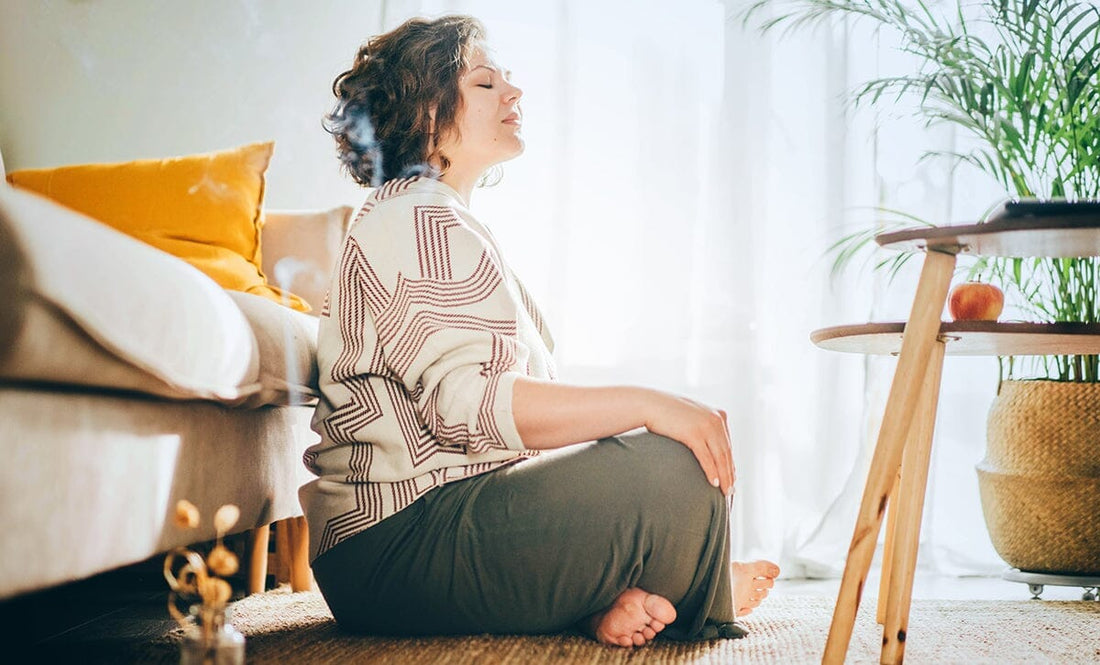How to Start Meditation Practice
Meditation has proven to be an effective adjunct treatment for a number of health conditions, including mood and anxiety disorders, insomnia, and even hypertension.1 Despite its benefits, the practice of meditation doesn’t always come easily to everyone. Sitting still, quieting one’s mind, and simply finding the time to meditate can be challenging.
In this article, we’ll offer some tips and strategies on how to calm anxiety by starting a meditation practice you can actually stick to. With these five practices, meditation will easily become a key component to your self-care routine.
The Five-Senses Start Up
Your senses–sight, smell, hearing, taste, and touch–are always at work, processing the world around you and tying you to the present moment. But many of us are so busy with our thoughts or too distracted to notice this sensory information. One way you can ease into meditation and become more comfortable being present is to focus on your five senses. You can try this during a walking meditation (because seated meditation is just one type!), ideally somewhere in nature.
On your walk, pay attention to your senses:
- Sight: focus on a flower or tree branch. Take in its texture, color, and imperfections.
- Smell: What do you smell? Breathe in the aromas around you and let them linger in your nose.
- Hearing: Do you hear birds chirping? The wind rustling leaves? Let the sounds rattle your eardrum and settle into your body.
- Taste: If you brought along a snack, take a small bite and let it sit in your mouth for a moment. Is it sour? Sweet? Salty?
- Touch: In addition to picking up a rock or leaf, pay attention to the feel of your foot against the ground, the swinging action of your limbs, and notice if you’re carrying any tension in your body. Can you let it go?
Meditation Mix and Match
Meditation doesn’t have to involve sitting for an hour in a lotus position or taking a sensory walk through nature. This practice is incredibly versatile, and there's no one-size-fits-all approach. In fact, you can even personalize your practice by mixing different meditation techniques to discover the blend that resonates most with you.
Meditation techniques to consider:
- Mindfulness meditation: The goal of mindfulness meditation is to simply be present in the here and now. As you sit with eyes closed, let thoughts come and go and notice sensations in your body without judgment or manipulation. Simply be in the moment, pulling your mind back when it starts to wander.
- Breathing meditation: There are a number of different breathing exercises you can try, like breathing in for a count of four, holding for seven, slowly breathing out for a count of eight, and repeating. Some use a technique of breathing in through one nostril while closing off the other, holding, and then breathing out the other. The point is to use your breath as an object of focus, which takes your attention away from your thoughts.
- Walking meditation: As discussed above, a walking meditation involves an awareness of your movements, and maybe the sensory information around you. You can also pay attention to your breath during a walking meditation, feeling the sensation as it flows in and out and following its rhythmic sound.
- Mantra meditation: A mantra meditation is an age-old practice that involves repeating a word, phrase, or sound either silently or aloud. The repetition helps focus the mind and induces a meditative state. Repeating “Ohm” is one such mantra.
- Progressive muscle relaxation: Sitting with your eyes closed or lying down, scan your body from head to foot, tightening and releasing muscles as you go. This is a great way to notice if you’re carrying around any tension in your body.
- Guided meditation: During a guided meditation, an instructor or recording guides you through a series of visualizations or prompts, helping you to relax and focus. These meditations are especially ideal for those who can use some support during their meditation, or to help them sleep.
Progress Points and Celebrations
Setting specific milestones and celebrating your progress can be powerful motivators on your meditation journey. You can start off small, aiming to meditate three times a week for five minutes at a time, and slowly extend the duration and frequency. Keep a calendar where you can schedule and check off your meditation sessions and think of small ways to celebrate or reward yourself. By recognizing the growth in your practice, you not only stay motivated but also cultivate a positive and rewarding relationship with meditation.
Mindful Movement
Similar to a walking meditation, mindful movement is a meditation that does not require you to stay seated. Practices like yoga or tai chi allow you to move slowly and focus on each movement, keeping you tied to the present moment. While a walking meditation may involve taking in the sensory information around you, mindful movement keeps your attention on the sensations in your body.
Inner Sanctuary Exploration
There’s a scene in the movie Eat, Pray, Love where the protagonist Elizabeth (played by Julia Roberts) is trying to meditate for the first time, but she keeps getting distracted by the idea of decorating the perfect meditation room. What she’ll realize soon enough is that the perfect meditation room lies within. Your mind is your sanctuary and home to numerous “rooms” you can explore and redecorate by selecting more positive thoughts. By exploring these rooms during meditation, you unlock deeper layers of self-awareness and connection.
At Brillia, mindfulness is one of the key components of our holistic 5-Pillar approach to reducing symptoms associated with anxiety and ADHD. At times, it may seem like meditation and ADHD are opponents, but with practice, you can master this tool. Along with proper nutrition, adequate sleep, controlled screen time, and taking Brillia, mindfulness practices like meditation have been proven to promote mental clarity and focus without the use of harsh, synthetic chemicals or harmful side effects. At Brillia, we know there’s no magic cure for anxiety or ADHD, but turning healthy lifestyle changes into habits helps to lay the foundation for long-term change.
Learn more about how the 5 Pillars work.







